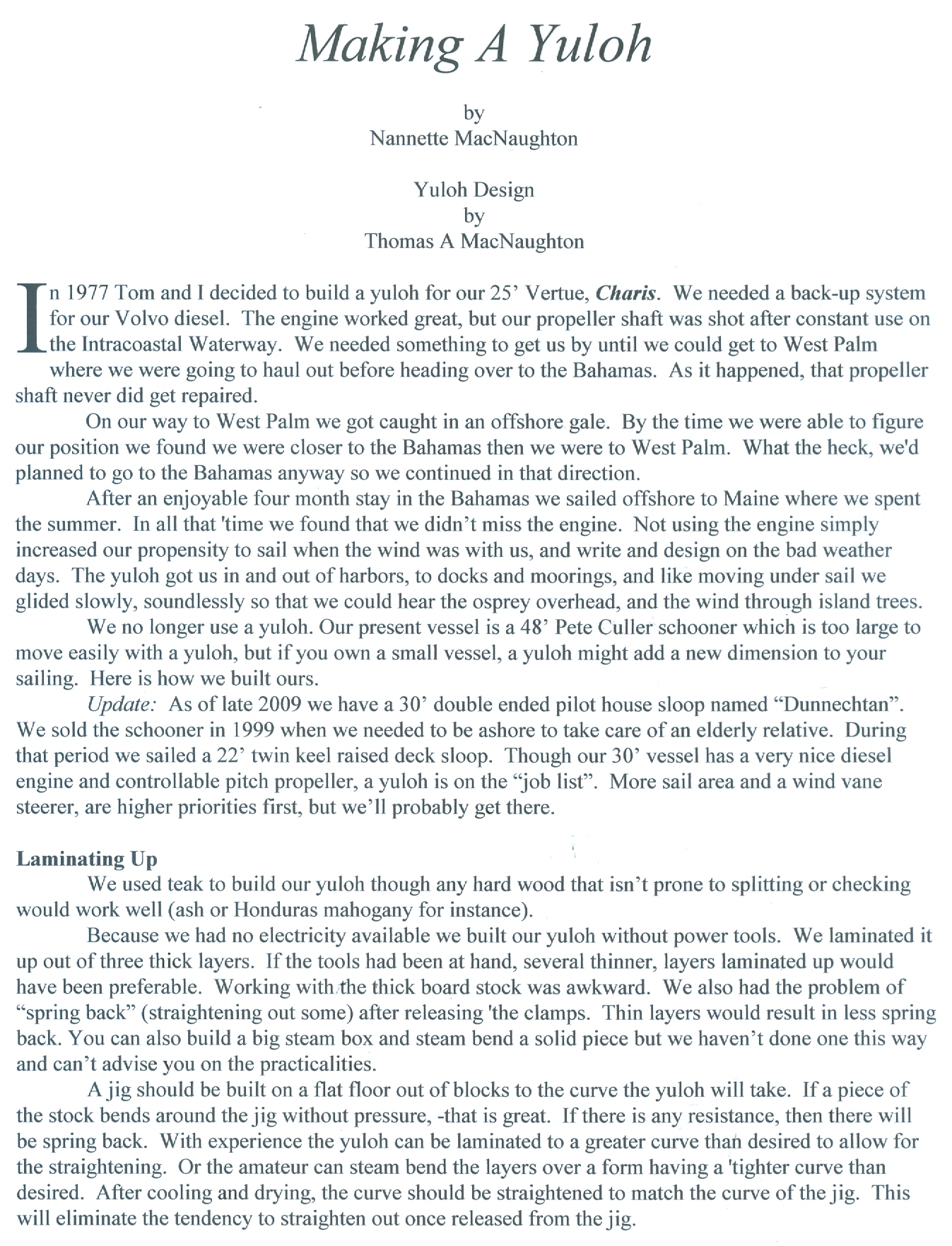 |
Many small yachts, especially those used for living
aboard and voyaging can ill afford the loss of space from fitting an
inboard engine and tanks. It is also worth mentioning that the
cost of an engine installation can pay for a number months of
cruising. Further if you don't have an engine you don't need
to maintain one, which takes time and money as well. On boats under 30' long we don't tend to recommend inboards. However there are times when you do need some kind of auxiliary propulsion. If the wind fails you along a coast, you may want to work away from the shore for fear of a current bringing you too close in before the wind returns. You might also decide to just anchor for the night or until the wind returns and want to work your way into the lee of an island to do so. You might also find yourself in a harbor that is so crowded that the ability to maneuver without having to wend your way between the boats under sail might be a good idea. In all these cases a yuloh is very helpful. While people may think of a yuloh as a "Chinese sculling oar". It is actually much more efficient than that. With its pivot on a pin at the stern, and a lanyard holding the yuloh at the right angle, you don't need to exert any effort to keep the yuloh in position. All your effort is used to make the boat go forward. Further it is not muscle but your weight that is used to propel the boat. You lean toward the oar and then away from it. One of our clients who had us design a yuloh for the 36' vessel we were designing for him and his family had lived aboard a junk in Hong Kong harbor and had said that it was very impressive seeing elderly women in their 80s yulohing heavy small vessels around the harbor. Are there times when auxiliary propulsion other than a yuloh is highly desirable? Yes, if you must enter a crowded harbor against a strong wind you don't want to be sailing and a yuloh, even with two people on it may not have the power you need. In this case you may want to have aboard a small gasoline or electric outboard which you can set up when you need to. Liveaboards and voyagers are likely to not want to keep an outboard on the stern all the time as it will be bad for the outboard. So even if you have an outboard aboard you will find that the instant availability of the yuloh makes it the most convenient choice much of the time. The other time when a yuloh won't quite do the job is in canal systems where a yuloh will work fine but you simply don't want to yuloh for hours on end. Again the outboard may be a good solution here, but even traveling in the Intracoastal Waterway of the East Coast of the United States, we often sailed a lot, only starting the outboard if there was a bridge to go through. Often, when we'd been sailing down the waterway for hours and decided to stop and anchor for the night in a little river or side creek, for one reason or another it was often convenient to simply run the yuloh out and work our way in so we could anchor, sometimes anchoring fore and aft, as many creeks were deep but quite narrow. The bottom line is that in boats under 30' there is a good argument for carrying a yuloh. This article will tell you how to calculate the right size yuloh for your boat and how to make it. Although we have a 30' boat now with a diesel engine and controllable pitch propeller, I still think about how nice it would be to have a yuloh at least for emergencies, and on any smaller boat would definitely prefer to have one over an inboard engine. (2 pages and a blueprint of the design, sent as pdf files) (tm) $18.00 |